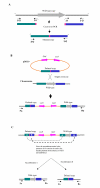Knock-out of SO1377 gene, which encodes the member of a conserved hypothetical bacterial protein family COG2268, results in alteration of iron metabolism, increased spontaneous mutation and hydrogen peroxide sensitivity in Shewanella oneidensis MR-1
- PMID: 16600046
- PMCID: PMC1468410
- DOI: 10.1186/1471-2164-7-76
Knock-out of SO1377 gene, which encodes the member of a conserved hypothetical bacterial protein family COG2268, results in alteration of iron metabolism, increased spontaneous mutation and hydrogen peroxide sensitivity in Shewanella oneidensis MR-1
Abstract
Background: Shewanella oneidensis MR-1 is a facultative, gram-negative bacterium capable of coupling the oxidation of organic carbon to a wide range of electron acceptors such as oxygen, nitrate and metals, and has potential for bioremediation of heavy metal contaminated sites. The complete 5-Mb genome of S. oneidensis MR-1 was sequenced and standard sequence-comparison methods revealed approximately 42% of the MR-1 genome encodes proteins of unknown function. Defining the functions of hypothetical proteins is a great challenge and may need a systems approach. In this study, by using integrated approaches including whole genomic microarray and proteomics, we examined knockout effects of the gene encoding SO1377 (gi24372955), a member of the conserved, hypothetical, bacterial protein family COG2268 (Clusters of Orthologous Group) in bacterium Shewanella oneidensis MR-1, under various physiological conditions.
Results: Compared with the wild-type strain, growth assays showed that the deletion mutant had a decreased growth rate when cultured aerobically, but not affected under anaerobic conditions. Whole-genome expression (RNA and protein) profiles revealed numerous gene and protein expression changes relative to the wild-type control, including some involved in iron metabolism, oxidative damage protection and respiratory electron transfer, e. g. complex IV of the respiration chain. Although total intracellular iron levels remained unchanged, whole-cell electron paramagnetic resonance (EPR) demonstrated that the level of free iron in mutant cells was 3 times less than that of the wild-type strain. Siderophore excretion in the mutant also decreased in iron-depleted medium. The mutant was more sensitive to hydrogen peroxide and gave rise to 100 times more colonies resistant to gentamicin or kanamycin.
Conclusion: Our results showed that the knock-out of SO1377 gene had pleiotropic effects and suggested that SO1377 may play a role in iron homeostasis and oxidative damage protection in S. oneidensis MR-1.
Figures







Similar articles
-
Transcriptome analysis reveals response regulator SO2426-mediated gene expression in Shewanella oneidensis MR-1 under chromate challenge.BMC Genomics. 2008 Aug 21;9:395. doi: 10.1186/1471-2164-9-395. BMC Genomics. 2008. PMID: 18718017 Free PMC article.
-
Transcriptional and proteomic analysis of a ferric uptake regulator (fur) mutant of Shewanella oneidensis: possible involvement of fur in energy metabolism, transcriptional regulation, and oxidative stress.Appl Environ Microbiol. 2002 Feb;68(2):881-92. doi: 10.1128/AEM.68.2.881-892.2002. Appl Environ Microbiol. 2002. PMID: 11823232 Free PMC article.
-
SO2426 is a positive regulator of siderophore expression in Shewanella oneidensis MR-1.BMC Microbiol. 2011 May 31;11:125. doi: 10.1186/1471-2180-11-125. BMC Microbiol. 2011. PMID: 21624143 Free PMC article.
-
Formate Metabolism in Shewanella oneidensis Generates Proton Motive Force and Prevents Growth without an Electron Acceptor.J Bacteriol. 2016 Mar 31;198(8):1337-46. doi: 10.1128/JB.00927-15. Print 2016 Apr. J Bacteriol. 2016. PMID: 26883823 Free PMC article.
-
Shewanella oneidensis MR-1 as a bacterial platform for electro-biotechnology.Essays Biochem. 2021 Jul 26;65(2):355-364. doi: 10.1042/EBC20200178. Essays Biochem. 2021. PMID: 33769488 Free PMC article. Review.
Cited by
-
Oxidative Fermentation of Acetic Acid Bacteria and Its Products.Front Microbiol. 2022 May 24;13:879246. doi: 10.3389/fmicb.2022.879246. eCollection 2022. Front Microbiol. 2022. PMID: 35685922 Free PMC article. Review.
-
Evolution of prokaryotic SPFH proteins.BMC Evol Biol. 2009 Jan 12;9:10. doi: 10.1186/1471-2148-9-10. BMC Evol Biol. 2009. PMID: 19138386 Free PMC article.
-
T6SS nuclease effectors in Pseudomonas syringae act as potent antimicrobials in interbacterial competition.J Bacteriol. 2024 Jun 20;206(6):e0027323. doi: 10.1128/jb.00273-23. Epub 2024 May 8. J Bacteriol. 2024. PMID: 38717111 Free PMC article.
-
Anaerobic respiration of elemental sulfur and thiosulfate by Shewanella oneidensis MR-1 requires psrA, a homolog of the phsA gene of Salmonella enterica serovar typhimurium LT2.Appl Environ Microbiol. 2009 Aug;75(16):5209-17. doi: 10.1128/AEM.00888-09. Epub 2009 Jun 19. Appl Environ Microbiol. 2009. PMID: 19542325 Free PMC article.
-
Identification of a TonB-Dependent Siderophore Receptor as a Novel Anti-Biofilm Target and Virtual Screening for Its Inhibitor in Pseudomonas fluorescens PF08.Foods. 2025 Feb 6;14(3):531. doi: 10.3390/foods14030531. Foods. 2025. PMID: 39942124 Free PMC article.
References
-
- Myers CR, Nealson KH. Bacterial manganese reduction and growth with manganese oxide as the sole electron acceptor. Science. 1988;240:1319–1321. - PubMed
-
- Myers CR, Myers JM. Fumarate reductase is a soluble enzyme in anaerobically grown Shewanella putrefaciens MR-1. FEMS Microbiol Lett. 1992;98:13–20.
-
- Myers CR, Myers JM. Ferric reductase is associated with the membranes of anaerobically grown Shewanella putrefaciens MR-1. FEMS Microbiol Lett. 1993;108:15–22.
Publication types
MeSH terms
Substances
LinkOut - more resources
Full Text Sources
Medical
Miscellaneous

